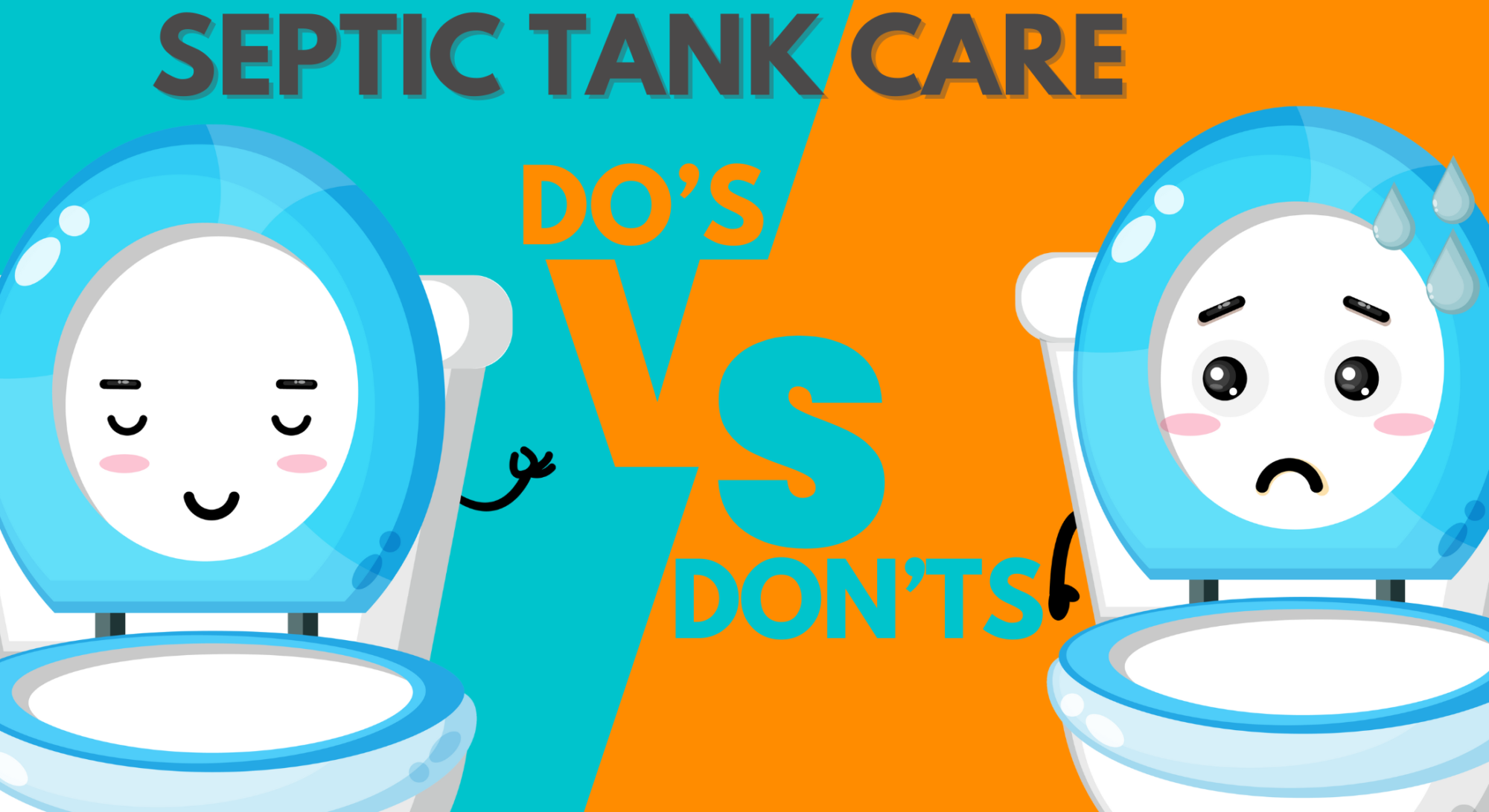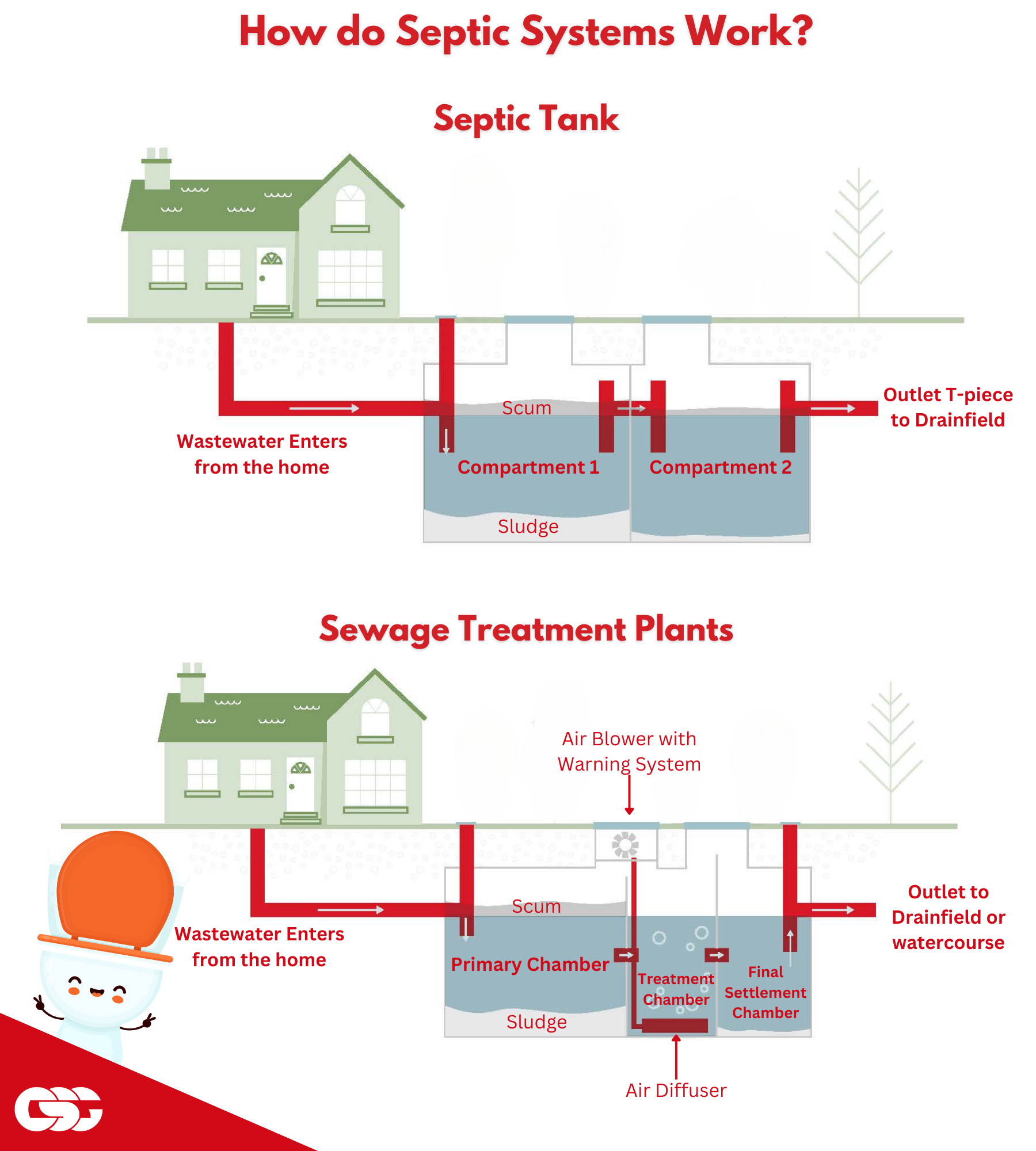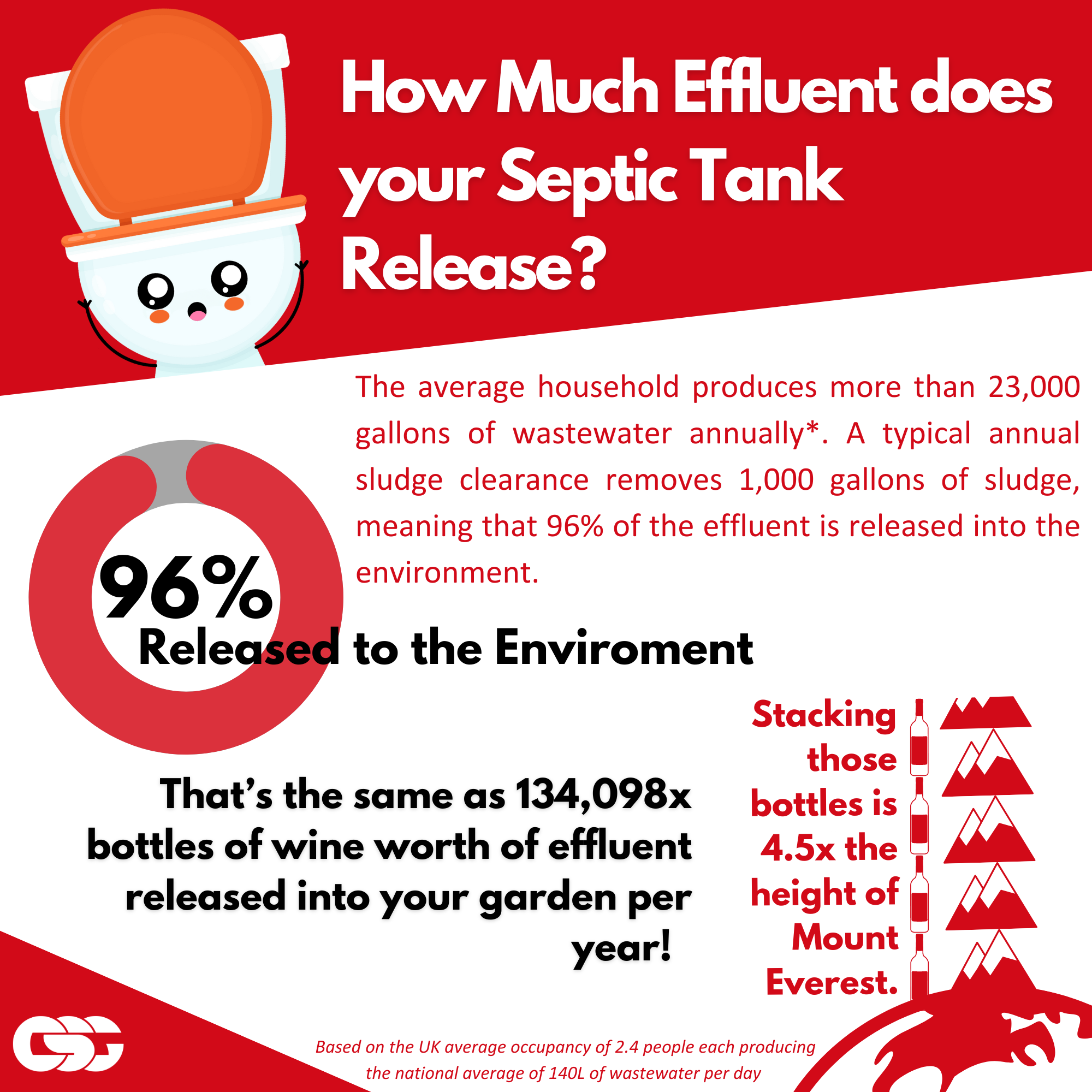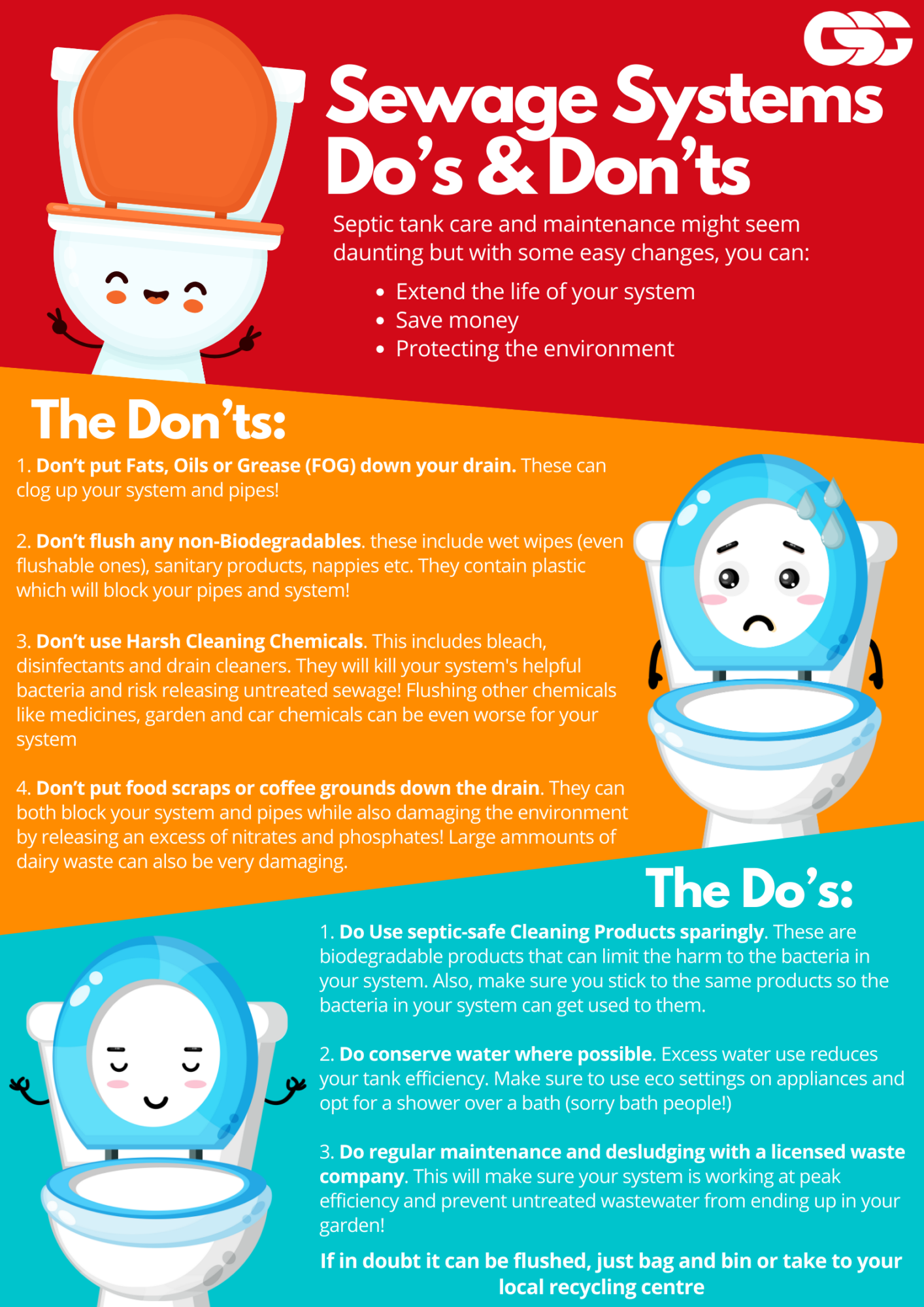Septic Tank Care – The Do’s & Don’ts
20 December 2023 by CSG

Septic tank and package plant care and maintenance can seem like a daunting task, but it’s surprisingly easy. Being mindful of what you’re doing inside your home is the best way to keep your system healthy, alongside regular maintenance and desludging. In this blog, we address the steps needed to ensure the health and longevity of your sewage system to save you money and protect your local environment.
How do septic and package systems work?
Your septic tank system consists of two main parts – a treatment tank and an outlet to the environment. For septic tanks, the primary treatment process is settlement under anaerobic conditions – where the sludge collects and ferments at the bottom of the tank. The settled, fermented liquid overflows and enters the drain field, where aerobic conditions allow for further treatment to occur.
Sewage treatment plants use aerobic bacteria, which can treat to a much higher standard. The friendly bacteria feed on the solid and liquid waste so the cleaned, treated effluent can be safely released into a drainage field or even a watercourse.
A septic tank can only release liquid into a drainage (infiltration) field where the bulk of the biological treatment occurs.
Wastewater from toilets, the kitchen, bathrooms and washing machines all drain into a septic system. On entering the tank, solid waste starts sinking to the bottom, creating a ‘sludge layer’. Lighter waste elements may float to the top to form a ‘scum layer’.
Between these two layers is a clearer, liquid layer, which will flow through further chambers. Depending on your system, there is (or should be) a lot of bacterial activity, further breaking down the organic waste from the middle layer.
If the sludge builds up and isn’t removed, poorly treated effluent waste from that middle liquid layer flows straight into the drain field on a septic tank or the biological zone in a treatment plant. This increases the chances of drain field blockage and overloading causing pollution to ground or package plant overloading causing pollution to water.
To protect water resources, ‘the general binding rules’ guidance produced by the Environment Agency, is in place for sewage treatment plant and septic tank system operators. It is your household’s responsibility to meet the rules set out in the guidance.
Refresh your understanding of these and check out the new guidance issued: from October 2023.
General binding rules: small sewage discharge to the ground – GOV.UK (www.gov.uk)
General binding rules: small sewage discharge to a surface water – GOV.UK (www.gov.uk)

Why is it important to care?

If you care for your septic tank system, your system will look after you. There are many reasons why you should care for your system.
- Financial savings – Good maintenance and following best advice will extend the lifespan of your system minimising the need for repairs or a replacement. Replacing your system can be extremely expensive and disruptive.
- Environmental impacts – If your system functions poorly, you increase the likelihood that untreated wastewater will leach into nearby soils, groundwater, or watercourses. This will contaminate and harm the environment and can even contaminate water supplies in some circumstances.
- Health and safety – Malfunctioning systems are a health risk because they can expose you, your family and your neighbours to harmful pathogens and pollutants.
- Property Value – A well-maintained sewage system enhances your property’s value. This makes it more attractive to potential buyers when you come to sell your property.

Septic tanks don’ts
Here’s what you shouldn’t put down your system:
- Fats, oils and grease (FOG) should not be put down your drain. These substances can solidify in the tank and clog up the system, reducing its efficiency.
- Non-biodegradable items – These include wet wipes (even if marked flushable), sanitary products, nappies, excess hair, floss and plastic wrappers. These materials can cause solid waste blockages that negatively impact your system’s health. Remember: your toilet is not a garbage disposal unit!
- Harsh chemicals such as bleach, disinfectants, and drain cleaners (even antibacterial hand wash or spray if used in excess) can disrupt the natural balance of bacteria in your septic system and hinder its ability to break down waste. If you need to use these cleaners, make sure you follow the recommended volumes found on the product label. Also, don’t swap brands as bacteria can build a tolerance to the brand you most often use, and swapping can cause even more damage to your system.
- Food scraps and coffee grounds – these should be put in the compost bin. Certain materials can collect and impede the decomposition process, therefore blocking pipes and outlets in your drainage field.
You should also be mindful of wasting water & using excess water. Too much water consumption can also reduce the efficiency of your septic system. Reducing water use can aid your system.
Keeping your system happy helps to reduce nutrient pollution in our water resources. If you would like more information on the damage that these nutrients can cause, check out our Habitat Protection and your septic tank blog.
Septic tanks do’s & best practices
On the other hand, here are some things that you can do or change to keep your system running smoothly:
- Use septic-safe cleaning products – Biodegradable and septic-safe cleaning products won’t harm the beneficial bacteria in your system. (CSG have previously recommended Envii Drain Klear for blocked drains and Eco Toilet Cleaning Gel for your toilet.)
- Water conservation – Toilets account for roughly a third of household water use, so be mindful of your water usage! Baths also typically use over double the amount of water to what a shower would use (sorry bath people!)
- Maintain your septic system – Regular maintenance and desludging from licenced companies like CSG will make sure your system can efficiently treat waste. It also reduces the likelihood that untreated wastewater leaves your system.
FAQs
It’s possible to use mild bleach sparingly if you have a septic tank. If you are bleaching your toilet or kitchen, it’s better to switch to a septic-safe product. These products won’t harm the bacteria in your system or reduce its effectiveness at treating waste.
No, you shouldn’t. Whether you have a septic tank or are attached to mains drains, sanitary products often contain plastics which don’t break down and can cause drains to block and systems to fail. These items can cause your wastewater to flood into your home/garden which avoids costly repairs and keep sanitary items out of your system.
Yes you can. If excessive water enters your system then the water will disrupt the solid waste and prevent it from settling on the bottom. If the water flow is too high, it flushes the bacteria out of the treatment zone and can result in inadequate treatment.
If in doubt, get in touch today!
If you do think that there’s a problem with your septic tank, we can help. We have over 90 years of experience helping off-mains drainage customers with their septic tank maintenance and will ensure your sewage system is running smoothly.
CSG are members of British Water and have accredited engineers for any of your wastewater service and maintenance needs. For more information please see their guide package sewage plant users.
Contact us on 0800 011 6600 today or click here to make an enquiry.
Click here to download the poster if you are interested in putting this up in your home/business to make sure others look after your system as well as you do.
